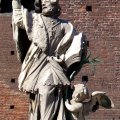This huge red brick building keeps the memory of the Viscontis and Sforzas, lords of Milan from the 14th to the 16th century.
Built by Galeazzo II Visconti in 1358, the Sforza castle was successively the residence of the lords of Milan, a military barracks and a hospital. Under Ludovico Sforza, known as il Moro (1452-1508), its court became one of the most famous in Italy, a point of attraction for the most important artists of the Renaissance. Having gone through several vicissitudes, Napoleon I ordered its destruction because of its dilapidation. Fortunately, this project was replaced by a vast redevelopment project that gave rise to the current circular boulevard around the castle, the Foro Bonaparte. Rescued once again from the ruins by the architect Luca Beltrami, he restored the entire building to its original state in 1893. The perimeter of the castle in quadrilateral, limited at each end by two cylindrical towers, is articulated around the central square (cortile delle Armi). Today, the Castello houses a museum in each of its wings, with several masterpieces. Plan a full day's visit if you want to see everything.
Museo archeologico. Two sections, the first dedicated to Prehistory with pieces of the various cultures that succeeded each other in Lombardy from the Neolithic to Antiquity, and a second dedicated to Ancient Egypt. Apart from a few interesting pieces, such as a curious ritual vase with three ducks (6th century B.C.), the collections of the other museums of the Castello are to be preferred.
Museo d'Arte Antica. It surprises with its very 1950s museography: a host of sculptures interact directly with the visitor. A journey through the history of the city: the visit begins with the symbolic passage under the Pusterla urbica (14th century) which once marked the entrance to Milan on the Contrada dei Fabbri side, towards the present Porta Ticinese. Not to be missed is the 14th-century monument to Bernabo' Viconti, topped by his equestrian statue, and the recumbent statue of Gaston de Foix, built in 1523 in pure Renaissance style. A bas-relief representing a young girl shaving her pubic hair (12th century) curiously recalls this kind of practice required among prostitutes at the time.
Sala delle Asse (first floor). Can be visited as part of the Museo d'Arte Antica itinerary. Leonardo da Vinci, invited to the Milanese court by Ludovico il Moro, decorated this room in 1498. The mysterious decoration completely covers the vaulted ceiling with vigorous mulberry branches, morus in Latin, an obvious tribute to the illustrious patron. Recently restored, preparatory drawings of the artist have appeared under the current fresco.
Armeria. The armory displays a very large collection of ancient weapons from the Middle Ages to the eighteenth century: armor, swords, rifles, pistols, muskets...
Museo Pietà Rondanini (first floor). In a wing open to the great square of arms. The ultimate work of Michelangelo, this is the most important piece in the Castello's collection. This unfinished sculpture, created in 1564, is the testament of an aged Michelangelo who worked on it until four days before his death. Although still in the sketchy state, the expressiveness and sensitivity of the rendering are at their peak here. The body of Christ, supported by Mary, is seized as it seems to be overcoming death, an allusion to the resurrection of the righteous originally intended for Michelangelo's own Roman tomb.
Museo dei Mobili e delle Sculture lignee (second floor). More than 200 pieces of furniture spanning six centuries of history, from Renaissance-era carved mounts to Ettore Sottsass' creations. Chests of drawers, chests, cabinets and secretaries. A curious automaton with a devil's head has become one of the cult pieces of the collection!
Pinacoteca (second floor). The Pinacoteca houses more than 1,500 works from the mid-15th century to the vedute of the Venetians Canaletto and Guardi (18th century), with some pleasant surprises including paintings by Mantegna(Madonna in Glory between Saints John the Baptist, Gregory the Great, Benedict and Jerome, 1497), Antonello da Messina(San Benedetto, 1470) and Giovanni Bellini(Madonna with Child, 1460). Particular attention is reserved for Lombard painters: Bergognone, Bramantino, Bernardino Luini(Hercules and Atlas), Marco d'Oggiono(Wedding of Cana, notice the surprising transparency of the glasses!).
Museo degli Strumenti Musicali. A rich collection of string, wind and keyboard instruments of all periods is kept here (on the second floor). Violins, mandolins, guitars, flutes and pianos abound. Lombard instruments are in the spotlight, but there is also a section devoted to instruments from around the world.
Museum of Decorative Arts (on the first and second floors). Exhibition of applied arts with a superb collection of ceramics. The Trivulzio Tapestries, masterpieces of Renaissance weaving illustrating the twelve months of the year (1480-1530), are a must.
Libraries. Castello Sforzesco has an impressive set of specialized libraries. They are reserved for researchers and you will need to make an appointment to consult their documents. Biblioteca Trivulziana (Monday to Friday from 9am to 12pm), Biblioteca archeologica e numismatica, Biblioteca d'arte (Monday to Friday from 9am to 12:15pm and from 1:30pm to 4:30pm), the Vinciana collection and the "Achille Bertarelli" collection of engravings, known by scholars all over the world.
Did you know? This review was written by our professional authors.
Book the Best Activities with Get Your Guide
Members' reviews on CASTELLO SFORZESCO
The ratings and reviews below reflect the subjective opinions of members and not the opinion of The Little Witty.
Find unique Stay Offers with our Partners





Seuls les extérieurs ont été vus, et c'est déjà une belle expérience !
A faire en plus du parc attenant.
Complessivamente il maniero è strepitoso. Bella l'area outdoor interna alle mura. Altrettanto gradevole la fontana all'entrata principale.